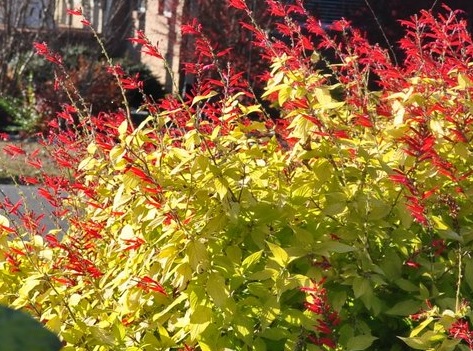
Submitted by Carol Reese, UT Extension horticulture specialist, Western Region
Pinch and sniff the leaf on any pineapple sage and you will understand why it has long been a beloved member of herb gardens. The sweet, slightly tropical scent is a good clue to its culinary uses. Commonly used to add fragrant dimensions to teas or fruit salads, you may also wish to add it to jams or jellies, or even to flavor pound cakes or shortbread cookies. This tropical essence was the plant’s best quality, since it is otherwise a rather dull member of the landscape for most of the season.
Enter ‘Golden Delicious’, a form with bright lemony foliage, discovered in Illinois in 2001. This gorgeous plant rivals coleus for landscape appeal.
Plant it in well-drained soil, in full sun or where it may get a bit of afternoon shade. Too much shade will dull the golden color. As the weather cools in mid to late fall, the brilliant red flowers spring from the terminals, proving irresistible to hummingbirds and butterflies. The plant will mature at two to three feet tall and wide.
This salvia is native to Mexico and Guatemala, found in naturalized colonies at high elevations. Where it is winter hardy, it can become a woody sub-shrub.
Generally considered to be a zone 8 plant, pineapple sage cannot be considered perennial throughout Tennessee, but is occasionally reported surviving our milder winters. To enhance your chances of it returning, mulch it deeply, but with a light fluffy covering of leaves or straw. A heavier mulch may keep its crown too wet for survival. Should it not return, this rewarding, easily grown plant is well worth replacing.
At the UT Gardens in Jackson, a lovely mass planting can be found in the large berm just south of the turf wheel.
Contact:
Carol Reese, UT Extension, 731-425-4767